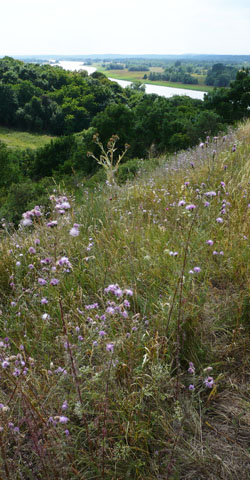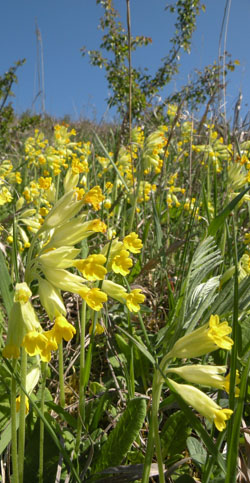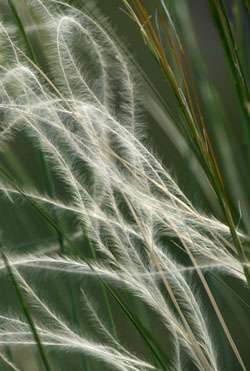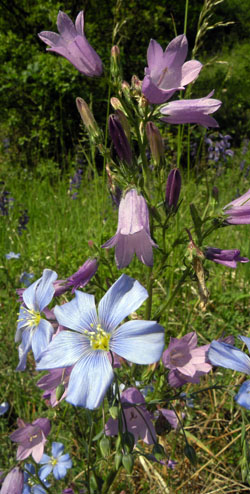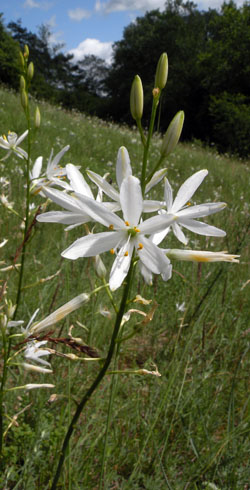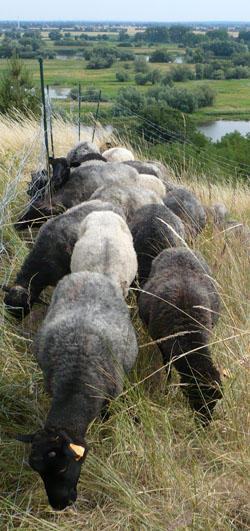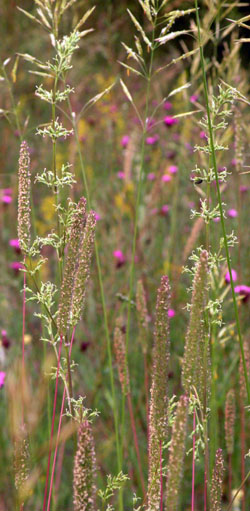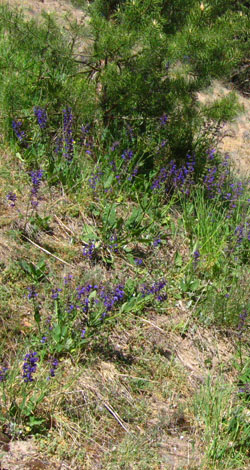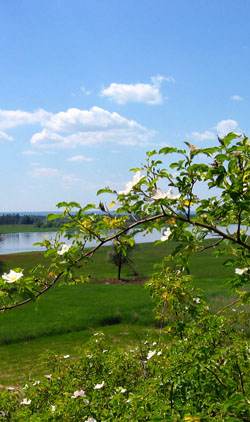The Dolna Odra Natura 2000 site, with an area of almost 30,000 hectares, was established to protect an almost 90 km. long stretch of the Oder valley and its edge zone between Kostrzyn and Szczecin. This area has been naturalizing over the past few decades. It includes an extensive flood plain with oxbows, riparian forests, reed beds, lowland peat-bogs, fresh and wet meadows together with those of a fluctuating water regime, dunes and other valuable habitats.
The specific, warm - for this latitude - climate of the Oder River valley, low rainfall and high number of sunny days during the year provide the conditions needed to sustain the many xerophilous and thermophilous plants found in the edge zone. For centuries, azonal xerothermic vegetation grew on the steep, sunny slopes of this naturally meandering river's escarpments, the Oder River of days past. The escarpments and eroding slopes occurring along the river valley formed a natural ecological corridor, enabling thermophilous species to migrate and enrich their gene pool with other populations. After the river was regulated, such habitats slowly began to disappear, succumbing to natural succession, which led to the establishment of shrub and forest assemblages. At the same time, the hunger for land resulting from the unproductive farming of Europe at the turn of the century led to the cultivation of every possible plot of ground that could be put into production. Every available fragment of the flatter moraine uplands was plowed, even the drained polders, whereas the escarpment slopes were used as pasture. Due to their steepness, sheep were usually put out to graze on the escarpments, less so goats. The extensive grazing of the Oder Valley escarpment halted ecological succession, enabling xerothermic assemblages to survive on its slopes.
River regulation and the retreat of its corridor from the foot of the escarpment made it possible to take economic advantage of the rich and easily accessible deposits of sand, gravel, and clay, whose many pits were established along the Oder's banks. To this day, many former pits remain, becoming excellent substitute habitats for xerothermic plants along the Oder due to their dry conditions, steep slopes and good sun exposure.
Paradoxically, then, on one hand humans halted the natural dynamic shaping the landscape of the river valley and its escarpments, but at the same time were instrumental in establishing substitute habitats that could be settled by thermophilous plant populations.
After World War II, the Oder Valley region depopulated, grazing practically disappeared and the xerothermic grasslands gradually began succumbing to successive growth. A significant portion, often very valuable patches of xerothermic grasslands, was afforested. Among the remnants of the Oder River valley's xerothermic plants, a small portion came under protection. One of the most valuable patches of thermophilous assemblages in the region is protected in the "Bielinek" Reserve. A patch of steppe vegetation is fairly well preserved thanks to the regular removal of woody growth within the borders of the "Wzgórze Widokowe nad Międzyodrzem" Reserve.
As part of this project, 13 main areas of concentrated xerothermic habitat sites have been designated for preservation activities, including:
Kurów
This is the northern-most stronghold of thermophilous grassland habitat on the lower Oder River. It is one of the last patches of the formerly rich xerothermic plant complexes on the western Oder escarpment, most of which succumbed to afforestation or single family housing development. Its proximity to an urban agglomeration negatively impacts the state of the grassland. Due to surface spillage from silos and food manufacturing facilities built along the escarpment's crest, the grassland is undergoing eutrophication and becoming overgrown with Rubus caesius. Part of the slope was destroyed by gravel excavation (currently illegal). But the grassland has retained many xerothermic and thermophilous species, including: Campanula sibirica , Veronica spicata or Potentilla arenaria.
The grasslands in Kurów, though they do not have a concentration of many rare species, comprise a local refugium of thermophilous plants. The existence of what is still a relatively well preserved patch of grassland decreases isolation and facilitates the migration of individual populations of xerothermic species in the Oder valley.
Moczyły
This is one of the few patches of xerothermic grasslands on the Oder River's western bank that has not been afforested or built-up. However, it is not grazed, so its northwestern part, with the character of a floristic steppe dominated by Brachypodium pinnatum, has been succumbing to succession and is becoming more of a thermophilous fringe assemblage of the Trifolio-Geranietea class. Shrubs of Crataegus monogyna and Pinus sylvestris saplings are infringing on the grassland. The more xerothermic western part of the grassland, characterized by a mosaic of Stipa and sandy thermophilous grasslands, is gradually being plowed, decreasing its total area from year to year. Despite the lack of individual legal protection, this site has maintained a rich and varied flora of rare and protected species, such as: Stipa capillata, Campanula sibirica or Scabiosa columbaria.
Krajnik
This is a group of three grasslands in the vicinity of Krajnik Dolny. The most valuable of these - "Żwirownia Krajnik" - is a mosaic of different, open, xerothermic vegetation as well as fringe assemblages. These grasslands are exceptionally short, rich in dicotyledonous species, such as Scorzonera purpurea, Scabiosa canescens, Medicago falcata, Anthericum ramosum or Salvia pratensis, giving them that special "floristic" character. The remaining two grasslands, comprising the western and eastern escarpment of a naturally eroding ravine, are somewhat poorer in species due to the well advanced stage of ecological succession there. The great proportion of species here are of thermophilous fringe types, such as Origanum vulgare or Galium verum. Eventual grazing should halt or even reverse the succession processes and maintain the grasslands' biodiversity.
The grasslands near Krajnik are one of the most valuable sites of thermophilous plants in the lower Oder River valley. Despite its small size, it has many rare species.
As is the case with the remaining sub-areas in the Dolna Odra site, Krajnik is a refugium for thermophilous vegetation, surrounded by an intensively developed landscape of crop fields and settlements. For this reason, it has tremendous value in its contribution to increasing the biodiversity of the region.
Raduń
The area between Raduń and Zatoń Dolna includes the steep slopes of the Oder River valley and the moraine hills, which meet the river corridor almost perpendicularly here.
The area is known for its uniquely variable terrain. In some areas, the uplands reach to almost 100 meters above sea level at inclines of even 50°. The hills are mostly made up of silty clay, rich in calcium carbonate. Groups of large erratic boulders are visible on the surface in only a few places, and the area lacks smaller stones and gravel.
These abiotic conditions resulted in the development of a specific combination of rare plant assemblages of the most extreme habitat types, which occur in varying successive stages on the slopes near Raduń and Zatoń Dolna: xerothermic grasslands (Linosyridi-Stipetum pulcherrimae, Potentillo-Stipetum and Adonido-Brachypodietum), species rich xerothermic shrubs (Querceto-Lithospermetum subboreale) and riparian woods on the slopes (Fraxino-Ulmetum). Other habitats listed in Annex I of the Habitats Directive are also found here: petrifying springs with tufa formation, lowland hay meadows, mixed oak-hornbeam forests and medio-european limestone beech forests.
A forest-steppe reserve near Raduń nad Odr± was already proposed for this site about 50 years ago. At that time, this area was compared to the well-known reserve in Bielinek. The steep hill slopes right by Raduń nad Odr± have long been known and valued as an exceptional site of xerothermic plants in the country. Stipa pulcherrima has been acknowledged as the most valuable flora element of this planned reserve. Currently, this is one of five existing sites of this rare grass in Poland. In 1960, this site was considered the country's largest uniform patch of xerothermic grassland dominated by Stipa pulcherrima. Other rare species found on the xerothermic slopes near Raduń are: Anthericum liliago, Carex supina, Carex humilis, Oxytropis pilosa, Linosyris vulgaris, Campanula sibirica, Campanula bononiensis, Cephalanthera damasonium, several species of broomrape (Orobanche), the spider Atypus muralis, the snail Helicopsis striata, several species of rare avian raptors and many others.
With this exceptional richness of species and habitats, the hills between Zatoń and Raduń fulfill a significant role in supporting a high level of biodiversity, not only on a regional scale, but also a national one, and even, given the presence of natural habitats and species here, on a European scale.
The main threat to the slopes between Raduń and Zatoń is forestry. Over the last few decades, a significant portion of the xerothermic grasslands found on the hillsides mentioned above have been afforested. Another threat is the abandonment of grazing in the non-forested habitats and the resultant natural succession that is occurring.
The entire area is found within the Cedynia Landscape Park.
Nawodna
This site includes a fragment of the Rurzyca River slopes transected by numerous small dry valleys. The entire area's substratum is mainly comprised of sand and sandy till. The soils that developed on these formations are either podzolic or poor brown soils. Pararendzinas occur on the steep, sandy slopes rich in calcium.
The valley's slopes run north to south. They are, however, crisscrossed by many ravines and xerothermic grasslands have developed on the warmer slopes with a southern exposure. Most of the slopes were planted with trees in the 1970s. Currently, thermophilous non-forest plants occur in small, isolated but numerous patches surrounded by a monoculture of pine or cultivated and abandoned farm fields.
The xerothermic grasslands are mainly represented by the Potentillo-Stipetum association, more rarely by the Adonido-Brachypodietum grassland. In places, thermophilous Festuco-Koelerietum and Sileno-Festucetum grassland associations are also found on the loose sands of the xerothermic grasslands. In patches forested with pine, specific associations of Pinus-Brachypodium pinnatum have developed.
In the 1970s, the grasslands near Nawodna were still considered one of the largest, species-rich assemblages of xerothermic plants in Pomerania. Despite afforestation, well preserved patches of xerothermic grasslands have survived here, as well as sites with rare species that found a place for themselves in the undergrowth of the pine plantations and at the edges of fields. This shows the great natural potential that still exists in this area. Anthericum liliago is among the plants occurring here listed in the Polish Red Data Book of Plants. Other rare and protected species are: Stipa capillata, Gentiana cruciata, Dianthus arenarius, Campanula sibirica, Oxytropis pilosa, Stachys recta, Odontites lutea and many more.
The main threats to the thermophilous plants near Nawodna are afforestation, illegal sand excavation and illegal trash disposal.
Cedynia
This site is on the side of a small ravine crossing the slope of the Oder valley. This southern-exposed slope has an incline of 30°-40° and is mainly built on clay till. Initially, brown and, in places, pararendzina soils developed on this type of substratum.
The prevailing types of vegetation here are the Stipa xerothermic grassland associations of Potentillo-Stipetum, Linosyridi-Stipetum and the Adonido-Brachypodietum xerothermic grassland. Thermophilous blackthorn and hawthorn shrubs grow only on the eastern side of the slope. Their expansion to other areas of the site is the main threat to this grassland near Cedynia.
Despite their lack of use and small area, the grasslands near Cedynia are fairly well preserved. Additionally, they represent the rarest and most extreme habitat type of Stipa grassland - with Linosyris vulgaris and Stipa pulcherrima.
The following species, rare in Poland, also occur here: Stipa capillata, Linosyris vulgaris, Stipa pulcherrima and Prunella grandiflora.
The terrain is unused, with only the crest of the slope planted with fir (a Christmas tree plantation). The main threats are natural succession and more recently, plowing of the slope's lower portions.
The entire area is part of the Cedynia Landscape Park.
Kostrzynek
Kostrzynek includes a fragment of the Oder River valley slope that is transected by ravines of varying sizes. The prevailing types of substrate are glacial sands and sandy till, with an admixture of small-grained gravel in places. Areas planted in pine have developed podzolic soils, with poor brown soils present in some areas, whereas pararendzina occurs on some of the slopes.
Stipa grasslands of the Potentillo-Stipetum association have formed on the open, warm ravine slopes and abandoned pit sites found here, along with the thermophilous, sandy grassland association of Sileno-Festucetum and Festuco-Koelerietum. Patches of grassland reach a maximum size of 3 ha and are scattered over the entire area.
As with most of the Oder River valley areas included in the project, the grasslands around Kostrzynek are a refugium of xerothermic plants surrounded by agricultural fields and tree plantations. They significantly increase the region's biodiversity. Some of the patches are well preserved and exhibit a character typical of the xerothermic grasslands in northwestern Poland. They include sites with such rare and protected species as: Stipa capillata, Stachys recta, Odontites lutea, Gentiana cruciata, Helicopsis striata and many others.
The main threats to the thermophilous non-forested habitats of Kostrzynek are afforestation and natural succession.
The entire area is within the Cedynia Landscape Park, and the Mieszkowice Forestry Division designated two sites - "Murawa pod Kostrzynkiem" and "Kartuzek" - as site of ecological interest.
Rudnica
This sub-area is in the valley of a small tributary of the Oder River. Its slopes are mainly comprised of glacial sands, on which podzolic soil developed, and some areas are richer in calcium carbonate - the pararendzina soils. The slopes are generally not very high, with inclines varying from 20° - 40°, and their exposure is mainly south and southwest.
Most of the slopes are forested, but some of them still have patches of Stipa grasslands of the Potentillo-Stipetum associations and the thermophilous Festuco-Koelerietum and Sileno-Festucetum sandy grasslands. They may be small, but are rich in rare species. In several cases, these assemblages have recolonized former excavated pit sites.
Despite their small size and extreme isolation, several of these patches contain some very rare species for the country. The largest of four known sites of Stipa borysthenica in Poland (a species in the Polish Red Data Book of Plants) is found in the Rudnica sub-area. Other rare and protected plants also found here include: Stipa capillata, Linosyris vulgaris, Thesium linophyllon, Ononis spinosa, Primula veris and Odontites lutea. Of particular note is the thermophilous fauna that occurs here, with, among others, the following listed in the Polish Red Data Book of Animals: Eresus cinnaberinus, Atypus muralis and Helicopsis striata.
The main threats are the extreme isolation of the patches and afforestation, as well as natural succession.
The entire area is in the Cedynia Landscape Park, and one of the grasslands - "Na nieużytku"- was designated an environmental use area by the Mieszkowice Forestry Division.
Trutwiniec
As with Rudnica, Trutwiniec consists of the valley of a small Oder tributary. Its slopes are mainly comprised of glacial sands with podzolic soils and some patches richer in calcium carbonate with pararendzina soils. The slopes are not very high, with inclines of 20° - 40° mainly facing south and southwest.
Most of the slopes are forested, but some still maintain patches of Stipa grasslands of the Potentillo-Stipetum association and the thermophilous Festuco-Koelerietum and Sileno-Festucetum sandy grasslands. They may be small, but are rich in rare species. In several cases, these assemblages have recolonized former excavated pits and the embankments constructed along railways and roads.
Despite their small size and extreme isolation, some of these patches contain some very rare species for the country. One of four known sites in Poland of Stipa borysthenica is found here, as well as Anthericum liliago and Carex supina - all these species are listed in the Polish Red Data Book of Plants. Other rare and protected plants occurring here include: Stipa capillata, Scorzonera purpurea, Pulsatilla pratensis, Ononis spinosa, Avena pratensis, Primula veris, and Odontites lutea. Also of particular note are the thermophilous fauna that occur here, among others Atypus muralis and Helicopsis striata, which are listed in the Polish Red Data Book of Animals.
The main threats are the extreme isolation of the patches and the incursion of Robinia pseudoacacia into the area.
The entire area is within the Cedynia Landscape Park.
Siekierki
This is a small fragment of an Oder River valley hillside. The slope has a southwestern exposure and is inclined at about 40°. It is made up of glacial sands rich in calcium carbonate.
The site constitutes a gap in the pine stand. It is entirely made up of Stipa grasslands of the Potentillo-Stipetum association.
This small area is highly significant in preserving the biodiversity, not only of the region, but of the entire country. It is one of four sites with the rarest Stipa in Poland - Stipa borysthenica. Additionally, Anthericum liliago and Stipa capillata are found here. The main threat to the site is the incursion of Robinia pseudoacacia. The entire area is in the Cedynia Landscape Park.
Gozdowice
Here we have a high (about 40 m) and steep slope of the Oder River valley with a southwestern exposure. The slope was formerly an excavated pit site and has an incline of 40°, and even 50° in some places. It is built on sandy till.
The main plant types here are Stipa grasslands of the Potentillo-Stipetum association. Despite the lack of use, it is in good condition, with individual shrubs and fruit trees found in only a few locations.
The slope near Gozdowice has one of the best preserved patches of xerothermic grasslands in the Oder River valley. It is a model site for this habitat. Among the rare species occurring here are: Stipa capillata, Odontites lutea, Ononis spinosa, Carex supina (a species in the Polish Red Data Book of Plants) and Stachys recta. This sub-area also has two species in the Polish Red Data Book of Animals: Atypus muralis and Helicopsis striata.
An environmental use area known as "Murawa ostnicowa" is found on most of the grassland, with the remaining portion comprising a gap in the pine stand. Its main threat is the incursion from the crest of Calamagrostis epigeios - an expansive stolonate grass.
The entire area is in the Cedynia Landscape Park.
Błeszyn
This high (about 40 m), steep and partly unstable slope of the Oder River valley has a southwestern exposure. As with Gozdowice, Błeszyn has long been an abandoned excavation pit, characterized by steeply inclined terrain. It is made up of glacial sands.
Błeszyn consists of the Stipa grassland Potentillo-Stipetum association, thermophilous sandy grasslands and thermophilous shrubs of the Berberidion association.
The slope at Błeszyn is one of the most valuable patches of xerothermic grasslands in the lower Oder valley. Among the rare species occurring here are: Stipa capillata, Odontites lutea, Ononis spinosa, Carex supina (a species in the Polish Red Data Book of Plants), Stachys recta. Błeszyn is also the site for two species in the Polish Red Data Book of Animals: Atypus muralis and Helicopsis striata.
The entire site is an environmental use area called "Murawa Błeszyńska" and within the boundaries of the Cedyna Landscape Park. Its main threat is the expansion of Robinia pseudoacacia.
Czelin
This large grassland complex (about 15 ha) is located in a naturally eroding ravine at the edge of a ground moraine along the Oder River valley near the village of Czelin. The sandy slopes of the ravine with their southern exposure are covered by Stipa grasslands dominated by Stipa capillata and Potentilla arenaria, with many colorful flowering species, such as Dianthus carthusianorum, Melampyrum arvense or Veronica spicata. Unfortunately, due to the lack of grazing, the grasslands have become largely overgrown, mainly with blackthorn brush. A "floristic steppe" with one of the largest populations of Campanula sibirica has developed on the westerly exposed slopes, in part due to the milder moisture regime and a greater proportion of suspended fraction in the substratum. Patches of thermophilous inland sandy grasslands have developed in the remains of the gravel pits in the southern part of the complex, mainly of Sileno otitis-Festucetum association, that is clearly evolving in the direction of a Stipa grassland.






